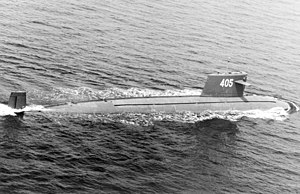Type 091 submarine
 Han-class SSN profile
| |
 A Type 091 submarine in 1993
| |
| Class overview | |
|---|---|
| Name | Han class |
| Builders | Bohai Shipyard, Huludao |
| Operators | |
| Succeeded by | Type 093 |
| In commission | 1974–present |
| Completed | 5[1] |
| Active | 3 |
| Retired | 2 |
| General characteristics | |
| Type | Nuclear submarine |
| Displacement | 5,500 tons (submerged) |
| Length | 98 m (321 ft 6 in) |
| Beam | 10 m (32 ft 10 in) |
| Draft | 7.4 m (24 ft 3 in) |
| Propulsion | 1 nuclear turbo-electric engine – pressurized water reactor |
| Speed | 25 knots (46 km/h)[2] |
| Range | Unlimited |
| Complement | 75 |
| Armament | 6 × 533 mm (21 in) torpedo tubes able to launch the RPK-2 |
The Type 091 (Chinese designation: 09-I; NATO reporting name: Han class) is a first-generation nuclear-powered attack submarine produced by China. It was the first nuclear submarine employed by the People's Liberation Army Navy Submarine Force,[3] and the first indigenously produced nuclear attack submarine in Asia.[4]
Background
The Chinese naval nuclear power program started in July 1958 when the Central Military Commission gave approval to start the Type 091 submarine project.[5] Mao Zedong declared that China would build nuclear attack submarines "even if it took ten thousand years."[6] Peng Shilu was the first chief designer of this project.[7][8][9] The first submarine in the class, Changzheng 1 ("Long March 1"), was commissioned in 1974;[3] the last was launched in 1990.[1] In 1983, Peng moved to the civilian development of nuclear power plants, and he was succeeded at the nuclear submarine project by Huang Xuhua.[10][8]
The Type 091 has operated mainly in local waters, and has been involved in several incidents. One submarine shadowed the
The boats have received major upgrades and numerous refits since commissioning. They have six 533 mm (21 in)
Criticism
The Type 091 is extremely noisy and has poor
Failed lease to Pakistan
In 1989,
Units
This article needs additional citations for verification. (December 2018) |
| Pennant number |
Name (English) |
Builder | Launched | Commissioned | Decommissioned | Status |
|---|---|---|---|---|---|---|
| 401 | Changzheng 1 | Bohai Shipyard, Huludao [18] |
1970 | 1974 | 2000[19] | Decommissioned in 2000. Preserved at the Chinese Navy Museum, Qingdao.[20] |
| 402 | Changzheng 2 | Bohai Shipyard, Huludao [18] |
1977 | 1980 | 2004[19] | Decommissioned in 2004 |
| 403 | Changzheng 3 | Bohai Shipyard, Huludao [18] |
1983 | 21 September 1984 [18] | Active | |
| 404 | Changzheng 4 | Bohai Shipyard, Huludao [18] |
1987 | November 1988 [18] | Active | |
| 405 | Changzheng 5 | Bohai Shipyard, Huludao [18] |
8 April 1990 [18] | December 1990 [18] | Active |
See also
- List of submarine classes in service
- Cruise missile submarine
- Attack submarine
References
- ^ a b Erickson and Goldstein (2007: 58)
- ^ Erickson and Goldstein (2007: 68)
- ^ a b Purser, Benjamin S. III; Chanse, Michael S. (3 August 2012). "Waypoint or Destination? The Jin-Class Submarine and China's Quest for Sea-Based Nuclear Deterrence". China Brief. 12 (15). Jamestown Foundation. Archived from the original on 11 November 2018. Retrieved 27 October 2018.
- ^ "China's Very First Nuclear Attack Submarines Had Some Major Fatal Flaws". 15 January 2017. Archived from the original on 2018-10-27. Retrieved 2018-10-27.
- ^ "Type 09-1 Han Class". Archived from the original on 2018-10-22. Retrieved 2018-10-22.
- ^ China’s ‘Long March’ to a Credible Nuclear Attack Submarine The National Interest Archived 20 May 2020 at the Wayback Machine
- ^ "The achievements of CNNC during the year 2017". www.china5e.com (in Chinese). 中国能源网. Archived from the original on 2018-11-08. Retrieved 2018-12-31.
- ^ Sina Corp. Archivedfrom the original on 2018-12-09. Retrieved 2018-12-31.
- ^ Erickson and Goldstein (2007: 59)
- ISBN 978-0-8108-7855-6. Archivedfrom the original on 2023-03-28. Retrieved 2019-01-15.
- from the original on 2020-07-13. Retrieved 2021-09-21.
- ^ "Faceoff Between U.S. Ship, Chinese Sub Is Revealed: Military: October incident in Yellow Sea highlights growing chance of naval conflict. Beijing sounds warning". Los Angeles Times. 1994-12-14. Archived from the original on 2021-09-21. Retrieved 2021-09-21.
- ^ "China Apologizes for Submarine Incursion". Archived from the original on 2006-10-23.
- ^ a b c Rehman (2012: 75)
- ^ Type 09-1 Han class Archived 2005-06-24 at the Wayback Machine, globalsecurity.org
- ISBN 978-1-315-48543-0. Archivedfrom the original on 1 January 2019. Retrieved 24 September 2018.
- ISBN 978-1-317-45956-9. Archivedfrom the original on 28 March 2023. Retrieved 24 September 2018.
- ^ a b c d e f g h i Jane's Fighting Ships, 2023-24 Edition, ISBN 978-0-7106-3428 3, page 133
- ^ a b "Meet China's First Nuclear-Powered Submarine (It Was a Total Disaster)". 6 December 2018. Archived from the original on 2019-05-09. Retrieved 2019-05-09.
- ^ Zhao, Lei (27 October 2016). "Nuke submarine to go on display". China Daily. Archived from the original on 1 January 2019. Retrieved 31 December 2018.
Sources
- Erickson, Andrew S.; Goldstein, Lyle J. (Winter 2007). "China's future nuclear submarine force: Insights from Chinese Writings". Naval War College Review. 60 (1). United States Naval War College: 55–79. Archived from the original on 28 October 2018. Retrieved 27 October 2018.
- Rehman, Iskander (Autumn 2012). "Drowning Stability: The Perils of Naval Nuclearization and Brinkmanship in the Indian Ocean". Naval War College Review. 65 (4). United States Naval War College: 64–88. Archived from the original on 28 October 2018. Retrieved 27 October 2018.
